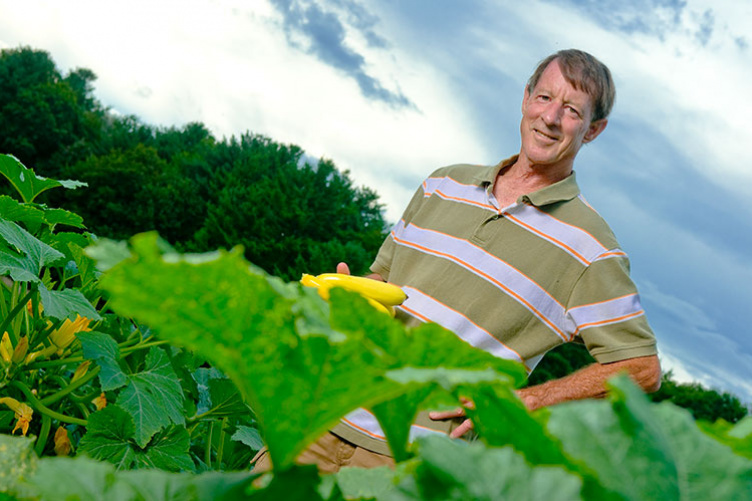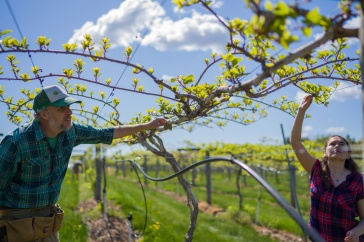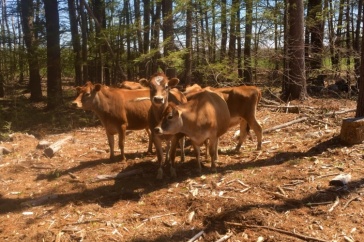
J. Brent Loy with Slick Pik summer squash
Soon, UNH will celebrate the work of one of its most prolific researchers. Over the last 50 years, Professor Emeritus J. Brent Loy, has developed more than 60 new varieties of squash, pumpkins, gourds, and melons. His work represents the longest continuous squash and pumpkin-breeding program in North America, and his varieties are sold in seed catalogs throughout the world. Plus, Loy is responsible for 29 percent of UNH's cumulative royalties earned since 1999.
UNH will honor Loy during a twilight ceremony Oct. 3 at Kingman Research Farm in Madbury, and the public is invited (RVSP here). Meanwhile, feast your eyes on this article from the UNH Magazine that describes Loy’s five-decade impact.
***
Brent Loy is on a quest for perfection.
On a sultry August morning, he stands in the middle of a field at Kingman Farm, surrounded by rows of low green plants whose broad leaves frame burgeoning fruits. He surveys the scene with an intensity one might not expect from a man surrounded by cantaloupes. But the boyish-looking professor, a plant biologist at UNH for almost 45 years, is not looking for something as simple as the ripest melon among the dozen or so that lie within arm's reach. What he's looking for is a cantaloupe that grows quickly, continues to ripen once picked, will stay ripe without spoiling for up to a week, and is high in sugar, and sweet and flavorful. When he finds it, he says, it will revolutionize the melon market. He knows the fruit he's looking for is not in his field today, but there's a decent chance its parent — or grandparent — might be.
Since the late 1960s, Loy has been UNH's "plant guy," a classically trained plant geneticist whose life's work has been breeding better plants. Focusing on vine crops in the gourd family, called Cucurbitaceae, he has developed hundreds of successful cultivars, more than 50 of which have become seed varieties for commercial sale. The catalogs used by backyard gardeners, as well as commercial farmers, are filled with the names of his creations: Earligold, Earliqueen, Passport, Sarah's Choice and Halona melons; Pik-aPie, Snackjack and Prankster pumpkins; Autumn Cup, Honey Bear and Slick Pik squash. Indeed, in the world of Cucurbitaceae, it would be hard to find a bigger name than that of J. Brent Loy — not that he's one to tout his own credentials. "I just like to farm," he says with a shrug.
Loy has always liked to farm. Born and raised in the Salt Lake City suburb of Bountiful, he knew from the age of 6 or 7 that he wanted to be a farmer, and by 9 he had secured his first summer farming job, working as a picker for a local vegetable grower. By 12 he had advanced to weeding onions and bunching radishes, and from 14 on he was a full-time summer farmhand, who took on some of the less savory jobs — like shoveling manure out of pig pens — once the harvest was over.

Undaunted by the hard work, Loy took his love of farming to Oklahoma State University, where he earned a bachelor's degree in horticulture in 1963. For his master's and doctorate in genetics at Colorado State University, he worked with the cucurbits that would later become the focus of his career.
Stretching back to Gregor Mendel and his pea plant experiments, which are still used today to teach high school biology students about dominant and recessive genes, nearly all genetic studies start with plants. This is because plants propagate quickly, and the success of crosses — whether or not desired genetic traits are expressed by the offspring — is generally quite easy to determine. "From the get-go, I was just really interested in the way you could create something that was better, and better in ways that were both visual and quantifiable, essentially with your own hands," he says. Unlike genetic engineering, which involves modifying DNA, classical plant breeding requires careful selection for desired traits over time, although Loy notes that an occasional lucky mutation can send your work in a direction you didn't expect.
When Loy arrived at UNH in 1967, his first project was to work with the university's existing lines of blue hubbard, buttercup and golden delicious squash. These so-called processing squashes are grown for yield and not just for eating fresh. As vine cucurbits, they need a lot of room to grow, so a more compact bush plant means more plants per row and thus more raw material for canned squash and pie filling and baby food.
"It maybe sounds funny, but a lot of times 'better' is about developing what's the most useful and not necessarily what's the most flavorful or the most beautiful or what have you," Loy explains. "The fun comes in trying to maximize other qualities like flavor and nutrition without sacrificing the characteristics that the growers most want."
Loy's bush squash hybrids were a success, and his work soon attracted the attention of New York-based agricultural supply company Agway, which approached him with a proposal to market and distribute his seeds. That sounded fine to Loy, who, still early in his UNH career, was more interested in his breeding work and teaching plant biology classes than becoming a commercial success.
***

Loy's initial partnership with Agway would turn out to be the beginning of a commercial juggernaut. Some four decades later, the companies he partners with stretch around the globe, from Johnny's Selected Seeds in Maine to seed companies in China and New Zealand that sell his melon, squash, gourd, pumpkin and tomato hybrids. About 20,000 pounds of his pumpkin seeds alone are sold each year — producing some 120 million pounds of pumpkins. One of his melon hybrids, due to its adaptability to the arid Middle East climate, is the leading cantaloupe crop in Saudi Arabia. And although the majority of them were developed for Northeast growing conditions, Loy's cucurbit varieties can be found growing in places as far flung as Russia, Spain, South Africa, Bulgaria, Serbia, Moldova, Uzbekistan and Turkey.
At UNH, Loy's success can be measured in the most concrete of terms. Since 1999, he has earned more than $1.1 million in royalties for the university's Office for Research Partnerships and Commercialization (now UNHInnovation), which was established to capitalize on the commercial potential of university research projects. While the office was established with an eye toward high-tech disciplines such as computer science and ocean and space engineering, it is Loy's work that has made the biggest mark. Over the past 12 years, his plant hybrids have accounted for approximately one-fifth of the university's license agreements and half of the total royalties. Last year, in recognition of his work, Loy received UNH's first Innovator of the Year award. In future years, the award will bear his name.

Loy has also won national breeding trophies, and his All-American Honey Bear hybrid squash has been a semifinalist twice for the national Agriscience Award. But what brings him out to Kingman Farm every day is the desire to help local farmers. "There are so many things that can impact the success of a harvest, and many are factors we now can breed for," he says. He has bred resistance to powdery mildew into many of his hybrids, for example, improved their nutritional content and increased uniformity in size and ripening time.
"There's such an extraordinary genetic variability in plant traits," Loy says. "You have to have an almost spiritual relationship with the plants you grow to understand how to bring out their optimal qualities."
***
Loy's relationship with his plants begins at the UNH greenhouse complex off Main Street. In January, in the only greenhouse with an "Authorized Personnel Only" sign on the door, he beds down the seeds that will become his parent plants. Into the spring, the seedlings are checked daily — if not by Loy himself then by one of his assistants, most likely master's candidate Jake Uretsky '12G or research technician Hua Cui '05G, '09G. Then, as the snow melts and the fields begin to color up, they prune and feed, string up lengths of sisal baling twine for the growing vines to climb, and monitor the production of flowers that might give rise to their first round of hybrid fruit. The process of creating a first generation, or F1, hybrid is painstaking and deliberate — a horticultural arranged marriage of sorts.
“It maybe sounds funny, but a lot of times ‘better’ is about developing what's the most useful and not necessarily what's the most flavorful or the most beautiful or what have you. The fun comes in trying to maximize other qualities like flavor and nutrition without sacrificing the characteristics that the growers most want.”
In early spring, once he's identified which two parent plants are carrying the different genetic traits he would like to cross, Loy chooses a "ready" female flower — easily identified by the immature fruit beneath the blossom — that he will hand pollinate with a corresponding male flower. The day before the female is set to open (the giveaway is a certain coloring to the petals, he says, and the slightest parting of the furled bud), he will clip together the tips of the petals with a pliable metal tab roughly the size of a pencil eraser. The following morning, he will remove the tab and pick his male flower, stripping away the petals to expose the pollen-laden stamen, and brush its pollen grains against the female's stigmatic surface. It's the birds and the bees in the most literal sense, minus the bees. (In the field, where bees are an issue, Loy prevents natural pollination with white mesh bags.) If the fertilization is successful, the female ovary will soon tell the story, swelling to form the growing pumpkin or squash or cantaloupe.
From the first of June on, most of the action moves to Kingman Farm. After extracting seeds from the most promising F1 fruits bred in the greenhouse, Loy and his students transfer the seedlings outdoors for his hybrid trials. Following a precise planting plan, they mark 5 acres of different hybrids — pumpkins and squashes, gourds and cantaloupes — with different colored flags. Loy puts in upwards of 12 hours a day in the summer heat, weeding and watering, monitoring the soil, spraying for beetles and mites, and warding off crows. By August, his acres are a sea of dark green leaves, yellow flowers and early fruit.

To the untrained eye, Loy's crops look flawless — endless rows of robust pumpkins and melons the likes of which the average backyard gardener only dreams of growing. But every summer Loy discards fully half of his trial yields, eliminating fruit for such negligible flaws as a protruding stigma or a displeasingly large blossom scar. The half that make the cut will be taken to the lab to be weighed and analyzed for nutritional content, percentage of fruit (the pulp, minus the water) and sugar. Seeds from the most promising fruits may be put aside to be used for another round of breeding. It can take more than four or five breeding trials — and as many years — to come up with the perfect matrix of traits.
Loy is pleased with his efforts to create a number of cantaloupe hybrids that have high sugar content, delayed ripening and a long shelf life. He's also created several varieties that are fast-ripening (32 days from fruit set, compared to an industry average of 45) and high in sugar (16.5 percent soluble solids versus an industry average of 11). The key to his perfect melon will be to combine just the right delayed-ripening, long-shelf-life line with the right fast-ripening, high-sugar line. He's close, he thinks, but he hasn't quite gotten it yet.
"Melons are a huge challenge, because there are literally dozens of different traits that you're selecting for," Loy says. The challenge is one reason melons are his favorite crop to grow, and his eyes fairly dance at the thought of creating the ultimate cantaloupe. "But, boy, do I really feel like I'm onto something right now."
***
The prospects for his cantaloupe notwithstanding, Loy is well aware that perfection and success in the market do not always go hand in hand. In the late 1990s, after two decades of pumpkin breeding work, he embarked on an effort to produce a pumpkin with commercial-quality hull-less seeds. Patiently crossing line upon line of pumpkins with large seeds, high seed yield and disease resistance, Loy envisioned a snack seed that would emerge from the pumpkin virtually ready to eat, loaded with protein and potassium and more flavorful than the ever-popular sunflower seed. The Snackjack hybridization was successful, and the seeds received rave reviews in taste tests, but to Loy's dismay, he soon discovered the U.S. market for his new creation was all but nil.
“From the get-go, I was just really interested in the way you could create something that was better, and better in ways that were both visual and quantifiable, essentially with your own hands.”
"I still couldn't tell you why," he says, mystified. "The seeds are delicious and they're healthy, with no cholesterol. And the pumpkin flesh itself is pie quality."
Another disappointment for Loy has been his inability to bring his immensely popular Thunder kabocha squash to the Japanese growers' market. Loy says Thunder is better than the product currently available in Japan (imported from New Zealand to the tune of $100 million a year) on virtually every dimension — quality, yield, color and flavor — but Japanese growers aren't allowed to grow it.
"That's just the way it goes sometimes, but it's frustrating to think about," he says. "Japan requires its growers to grow this one particular variety that was developed by a Japanese seed company in the late 1970s. When you think about all the improvements we've made to these kabochas in the last 30-plus years, that's just nuts."
Loy cares that Japanese growers are denied access to a better product, and he cares that growers in New Hampshire and California and Canada are successful in their efforts to grow beautiful, healthy fruit and vegetable crops. To that end, he has become a singular resource for industry organizations. He advises the Canadian Department of Agriculture and Agri-Food on planting tips, lectures abroad on intellectual property agreements for sharing germplasm (seed bank), and gives The New York Times his expert opinion on what to do about winter squashes that have a "squunky" taste. (Throw them out, he says.) He collaborates with breeders at seed companies — including Johnny's Selected, High Mowing Organic Seeds and Rupp Seeds — to create new, joint hybrids bred from one of his parent lines and one of theirs, often to great effect. His award-winning Honey Bear squash, for example, was a joint hybrid created with Rob Johnston at Johnny's Selected Seeds.

One area where Loy tends not to get involved is in the naming of his cultivars, a task he typically leaves to the seed companies (although he did name the Snackjack). The trade-off is simple: he grows hybrids that taste delicious; the companies give them "delicious" names.
***
Having recently logged both his 70th birthday and a knee replacement, Loy flirts with the idea of retiring, but there are always new hybrids to tackle, like a moschata-maxima cucurbit cross he and Uretsky are working on. There are recent successes to nurture, like his 2008 Slick Pik yellow squash that has smooth, not prickly, stems, meaning less fruit damage at harvest time. And though he is best known for his research, Loy feels an obligation to provide practical, hands-on learning to students.
"When I started here back in the 1960s, it wasn't unusual for students to come from farming families, and to get their degree with the intent of going back to the farm," he says. "Now, though, students tend to come with somewhat romanticized ideas about agriculture. That's not to say I want to discourage them from being farmers. It's just important that they have a realistic picture of what they're signing themselves up for."
Loy sees a lot to be optimistic about in new programs such as UNH's sustainable agriculture and food systems major and in individuals like Uretsky and Cui, who represent the next generation of his work. "The project Jake is working on right now is cross-species" involving a pumpkin and a squash, he explains. "Like when you breed a horse and donkey and get a mule. If it works, it will be something that's never been done before."
Join the Celebration

Join us to celebrate J. Brent Loy’s success on Oct. 3 from 4:30 – 6:30 p.m. at the Kingman Research Farm in Madbury.
These days, Loy is "half retired" — he no longer teaches, and he holds a part-time appointment, supported by the N.H. Agricultural Experiment Station, to continue his breeding work through 2013. (NHAES also has supported Loy's research, and provides funding for Kingman and Woodman farms and the UNH greenhouses.) Eventually, he sees himself shifting the balance of his time from the university's 360 acres to the 5 he maintains at home in Epping with his wife, Sarah, where they grow much of their own produce. But as he moves among his Kingman cantaloupes — picking up a heavily netted tan fruit, opening up his pocket knife to carve out a wedge-shaped plug of the flesh, orange and fragrant in the summer heat — it's not hard to imagine him here for many years to come. Indeed, after tasting the cantaloupe, he tosses it to the side and upends the stake that marks this particular cross. It's ripened just a bit too soon, and while it's good — delicious, even — it isn't perfect. Not yet, that is.
Originally published in UNH Magazine Spring 2012 Issue
-
Written By:
Kristin Waterfield Duisberg | Communications and Public Affairs

















































